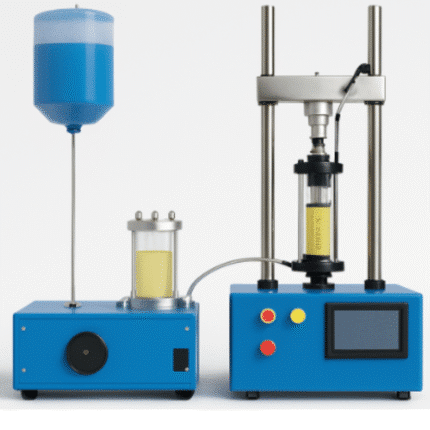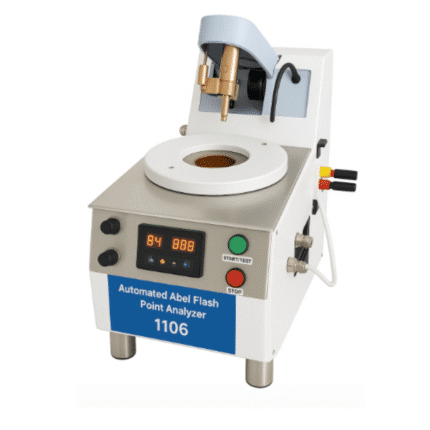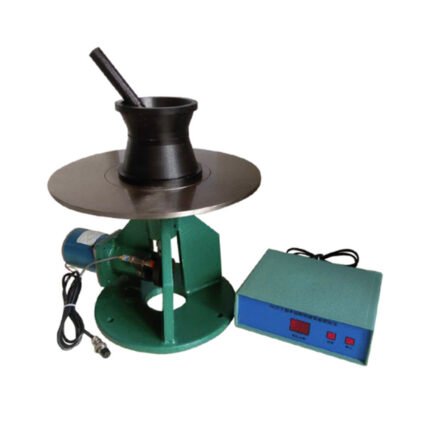AZA 0793 FLOW TABLE
- Measures mortar and concrete flow and workability
- Manual drop mechanism for reliable consistency testing
- Built as per IS 1199 and ASTM C230 specifications
- Includes mould, table, handle, and drop cam
- Used in site QC, R&D, and cement lab applications
Description
Flow Table is a standardized lab instrument used to determine the workability, consistency, and flow of fresh cement mortar or concrete. This simple yet precise testing tool helps identify how easily a mix spreads under its own weight after a controlled mechanical impact. It is a critical part of material quality control in construction projects and cement laboratories.
The Flow Table consists of a rigid circular metallic surface mounted on a sturdy base. At the center of the table is placed a conical mould, which is filled with fresh mortar or concrete. The mould is then lifted, and the table is dropped a fixed number of times using a handle-operated cam mechanism. The extent to which the material spreads across the table indicates its flowability and consistency.
The test conforms with both IS 1199:1959 – Methods of Sampling and Analysis of Concrete and ASTM C230/C230M – Standard Specification for Flow Table. These standards define the equipment dimensions, drop height, and number of drops to ensure consistent and comparable results across labs and test sites.
Components:
-
Flow Table Plate: Made of brass or stainless steel; typically 762 mm in diameter
-
Drop Mechanism: A hinged or cam-action system that raises and drops the table uniformly
-
Flow Mould: Frustum-shaped cone (100 mm height, 100 mm top, 200 mm base diameter)
-
Handle: Manually operated lever for dropping the table
-
Base Frame: Heavy base to absorb impact and provide stability
How the Flow Table Test Works:
-
The flow mould is centered on the table and filled with a fresh mortar or concrete mix.
-
The mix is tamped (as per standard) and the mould is lifted vertically.
-
The table is then dropped 25 times from a height of approximately 12.5 mm.
-
The final diameter of the spread sample is measured in two perpendicular directions, and the average is recorded as the flow value.
This value helps determine if the mix is suitable for applications like grouting, overlay work, or precast manufacturing, where flowability is critical. A higher flow value indicates greater ease of placement and compaction, while a lower value may signal stiff or under-mixed material.
Applications:
-
Cement and mortar quality control in laboratories
-
Field testing on construction sites
-
Evaluation of admixture effectiveness
-
Comparison of water-cement ratio effects
-
Teaching aid in civil engineering laboratories
Benefits:
-
Simple and repeatable testing method
-
Portable and manually operated – ideal for field use
-
Provides quick feedback on mix behavior
-
Helps reduce trial-and-error during mix design
-
Compliant with both national and international standards
Additional Usage Notes:
The test is particularly valuable when working with self-leveling mortars, grouts, or repair materials, where even minor changes in consistency can affect performance. It also helps optimize admixture dosage, such as plasticizers and superplasticizers, by showing direct impact on flow characteristics.
Specifications:
| Parameter | Specification |
|---|---|
| Table Diameter | 762 mm (30 inches) |
| Drop Height | 12.5 mm to 25 mm |
| Table Material | Brass, stainless steel, or mild steel |
| Flow Mould Dimensions | 100 mm H × 100 mm top Ø × 200 mm bottom Ø |
| Number of Drops | 25 (standard) |
| Operating Mechanism | Manual lever with cam-action |
| Standards Compliance | IS 1199:1959, ASTM C230 |
| Application | Cement, mortar, concrete workability tests |
Frequently Asked Questions (FAQ):
Q1: What does the Flow Table test measure?
It measures the flow or spread of mortar/concrete, indicating its consistency and workability.
Q2: Is this test suitable for concrete as well as mortar?
Yes. It’s widely used for both, especially in highly workable mixes like grouts, overlays, and micro-concrete.
Q3: Which standards does the Flow Table comply with?
It complies with IS 1199:1959 and ASTM C230.
Q4: How many drops are required for a standard test?
Typically 25 drops are made, as specified by both IS and ASTM procedures.
Q5: Can this equipment be used on-site?
Yes. Its manual design and durable construction make it suitable for both lab and field conditions.
Additional information
| Table Diameter |
762 mm (30 inches) |
|---|---|
| Drop Height |
12.5 mm to 25 mm |
| Table Material |
Brass, stainless steel, or mild steel |
| Number of Drops |
25 (standard) |
You may also like…
Advanced Triaxial Test System (UU–CU–CD Capable) (AZA 1296)
- UU–CU–CD test modes for complete soil strength profiling
- Automated control of pressure, load, and drainage
- Compatible with clay, silt, sand, and mixed soils
- Integrated data acquisition and real-time graphing
- Meets ASTM D2850, D4767, BS1377, AASHTO standards
- Ideal for geotechnical, research, and academic use
Air Bag Trainer (Model AZA1246)
Alternator Trainer (Model AZA1247)
Arc Welding Machine (AZA 1234)
AutoDist‑86 Glass Distillation (AZA 1282)
AutoFlash – Automated Abel Flash Point Analyzer( AZA 1277)
AZA Lab's AutoFlash-1277 is a fully automated, microcontroller-based Abel Flash Point Analyzer designed to accurately determine the flash points of combustible liquids. Conforming to IP 170, ISO 13736, and IS 1448 (P:20) standards, it ensures precise and safe analysis of samples in the temperature range of -30°C to 70°C, extendable up to 110°C.
Equipped with a built-in PC and touchscreen display, the AutoFlash-170 delivers intuitive operation, automated calibration, advanced ignition options, and rapid heating procedures for high-efficiency testing. Ideal for laboratories, petrochemical industries, and quality control applications, this standalone unit streamlines the testing process with enhanced accuracy, safety interlocks, and programmable procedures.
Related products
AZA 0787 BLAINE’S AIR PERMEABILITY APPARATUS
AZA 0789 RING MOULD
AZA 0794 FLOW TABLE (MOTORISED)
AZA 0795 LE CHATELIER MOULD
AZA 0803 TENSILE STRENGTH TESTER (ELECTRICALLY OPERATED)
- Electrically operated tensile testing machine
- Tests cement briquette strength up to 1000 kg
- Conforms to IS 4031 (Part 6), ASTM C190
- Sturdy construction with powder-coated finish
- Optional digital load readout version available
- Includes standard specimen holders and accessories
AZA 0806 STANDARD SPATULA
AZA 0810 FULLY AUTOMATIC MORTAR MIXER
- Fully automatic mortar mixing system
- PLC-based programmable controls
- Dual-speed planetary motion for uniform mix
- Stainless steel mixing bowl and blades
- Follows ASTM and IS testing standards
- Ideal for labs, R&D, and educational setups
AZA 0813 PLUNGER PENETRATION APPARATUS
- Measures consistency of cement mortar mixtures
- Complies with IS 4031 (Part 6) and ASTM standards
- Durable plunger with easy depth measurement scale
- Ensures reliable and repeatable results
- Compact and corrosion-resistant lab design
- Ideal for labs, cement plants, and research facilities

 Rock
Rock Aggregate
Aggregate Cement
Cement Concrete
Concrete Soil
Soil Steel
Steel Bitumen/Asphalt
Bitumen/Asphalt Security Survey Equipment
Security Survey Equipment General Items
General Items

















